
Product Lead | Concept | UI / UX
Graphics | Branding | Name
Videobesuch is a videocall software specifically designed for nursing homes during the Covid19 pandemic. It allowed nursing homes to offer videocalls to their residents, by using our accessible software and automatic scheduling system.
Videobesuch serviced 300 B2B customers and was profitable within 3 months. Videobesuch emerged as the winner of the government backed WirVsVirus competition with over 28,000 participants and the VISA Inc. business competition.
Videobesuch collaborated with Caritas, Vodafone and MediaMarktSaturn and was featured across German mainstream media like BILD,
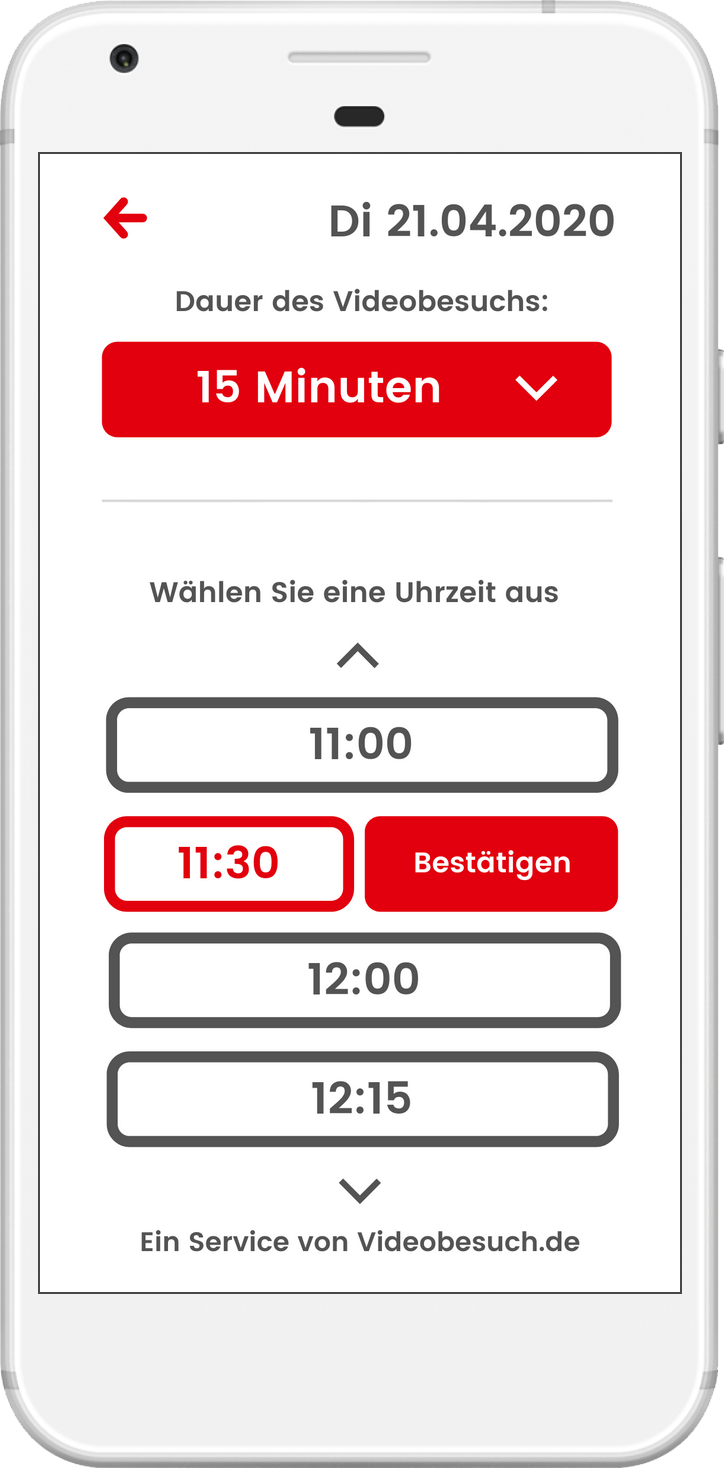
About Videobesuch
What is Videobesuch?
Videobesuch is a video call software designed specifically for nursing homes, offering an integrated automated scheduling service. This solution simplifies the process of facilitating video calls for residents, even amidst limited staffing or device availability.
The software emphasizes accessibility, minimizing caregiver involvement. Family members can utilize the automated scheduling feature to arrange calls, which are seamlessly integrated into caregiver schedules. When the scheduled time arrives, caregivers merely need to bring the tablet to the resident. The call initiates automatically at the designated time with maximum volume and concludes upon completion. The user interface intentionally restricts options to prevent accidental closure, ensuring a user-friendly experience for residents.
Why Videobesuch was created
During the hackathon, our focus was on identifying particularly vulnerable segments of society during the pandemic. Our attention quickly turned to individuals in hospitals and nursing homes who were deprived of in-person visits due to Germany’s COVID-19 regulations.
A significant number of nursing homes in Germany lack adequate internet connectivity, and technical devices are frequently absent. Consequently, numerous individuals found themselves entirely isolated from their families, with occasional phone calls being their sole connection through the nursing home’s landline.
In response, we developed Videobesuch as a targeted solution to address the challenges posed by the pandemic. Our goal was to facilitate family reunions by providing a platform that specifically catered to the COVID-19 circumstances.
Product Background
Videobesuch was developed during the WirVsVirus hackathon held by the German government in March 2020. The business operated until August 2021.
Videobesuch primarily targets nursing homes and their residents, addressing challenges such as limited access to technical devices and residents’ unfamiliarity or physical limitations when dealing with intricate software.
MY ROLE:
Co-founder, PR & Marketing, Product & Design
Collaborated with my colleagues to design the app and manage the product’s features, development and marketing efforts.
Understanding our Users
Since we participated in a hackathon, we had to move at at an exceptional pace. We orginally conducted secondary research online, also taking our own experiences and stories into account. Due to the prevalence of news articles elaborating on how elderly people in German nursing homes or hospitals ended up dying without any way of saying goodbye to their families, we knew that there’s a strong pain point right there.
After we built our initial solution, we leveraged in-app feedback pop-ups and personal 1on1 chats to further develop our app.
Pain Points
Caregivers are too busy
They don’t have time to manually schedule calls or sit with the residents during videocalls to make sure that everything goes smoothly.
No technical devices available
Nursing homes don’t have tablets available and oftentimes not even an internet connection. Most of the residents lack the tech affinity to operate devices on their own.
No contact with their family
Besides using the nursing home’s landline, the residents weren’t able to contact their family at all, since the covid rules in Germany didn’t allow personal visitations.
The Solution
Partnerships
We partnered with large electric device retailers to provide a complete package to nursing homes including a tablet, our software and a data plan, making it easy to get started.
Low time commitment
Scheduling calls is automated through a calendly-like solution. Additionally our interface is hands-off: The residents don’t have to interact with it in any way, resulting in no need for additional guidance.
Videocalls with Videobesuch
Our system allows the family members of residents to schedule calls within a timeframe set by the nursing home, ensuring that the videocall can happen without any roadblocks.
Persona: Resident
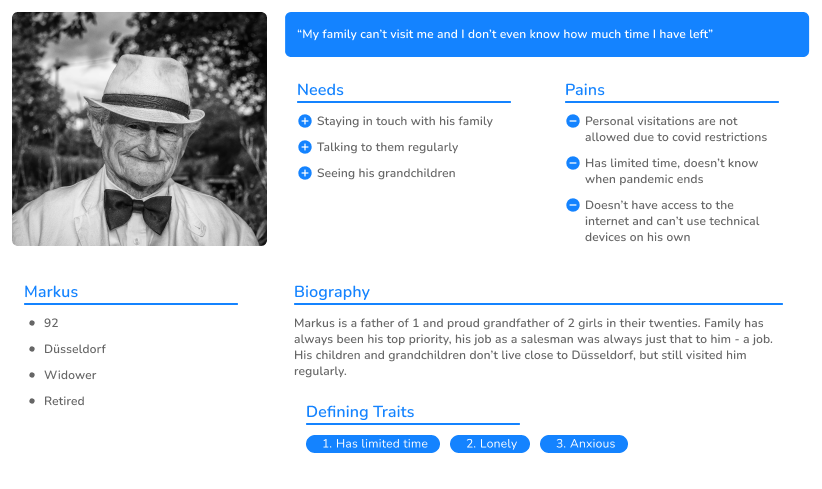
Persona: Family Member

Designing Videobesuch
Due to strict time constraints, we originally skipped the wireframe stage and instead prepared mockups with Canva.
For scheduling video calls, we prepared a quick prototype in Marvel, that you can view here.
Takeaways
Videobesuch was the second company I started and a very fast paced product to work on. It was an absolutely amazing learning experience.
The time constraints of the competition forced us to take short cuts, but ultimately allowed us to quickly pilot and pivot our product based on real life feedback. In a sense Videobesuch is a really great example of the lean startup approach, reaching MVP status after about one week. After gaining some valuable feedback during our pilot with Caritas, we developed the next interation and started to onboard more customers. We then quickly gained traction through the press coverage and our partnership, propelling us to profitability within a very short time.
This rollercoaster provided all of us with many learning points across business, marketing, development and design.
One of the biggest challenges was, that none of us had any direct experience with the nursing home system and their day to day activities. Because of that, we initially had to make a lot of assumptions and best guesses, while staying open to having them either confirmed or debunked.
Videobesuch helped me gain a lot of experience in UX research, designing for accessibility and in working in a fast paced environment, where you can’t always take the proper step-by-step way, but have to find ways to make things work with just little information and time.
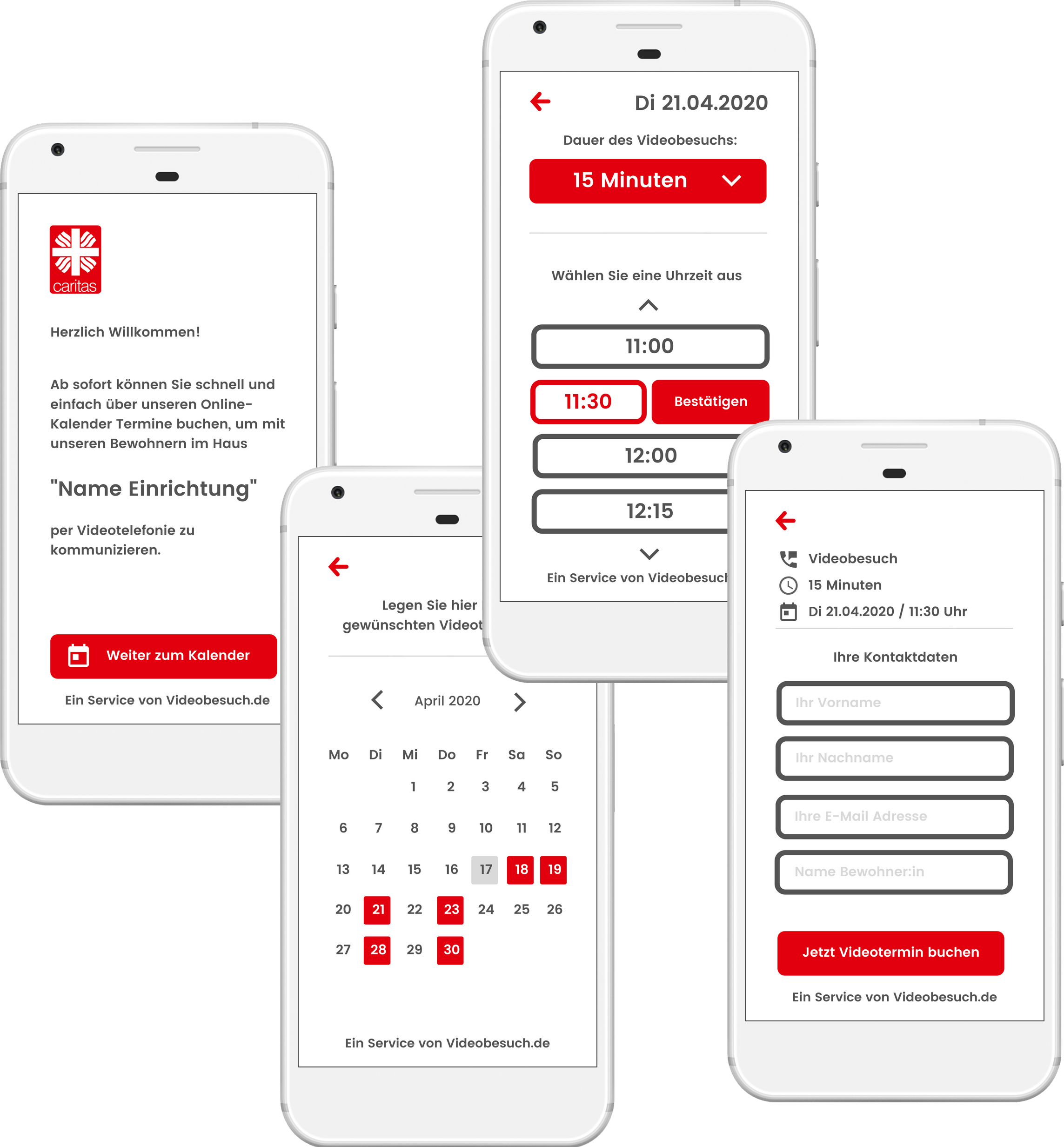
Scheduling Process
In our white label solution, nursing homes where able to provide their branding and color scheme for better recognizability. For example, the mockups on the left have been adapted to Caritas red color scheme.
The Process:
The residents’ family member will receive an email from Caritas introducing the new service they added: Videobesuch. This includes a link to the nursing home’s main page.
On this booking page, they can first pick a date in the calendar and then customize the appointment. In order to do so, they pick a time frame and time. The timeframe setting allowed us to complete automate the call and was also crucial in maintaining a smooth process for the nursing homes.
Afterwards, they enter their own name, the name of the resident, their email address and confirm their “Videobesuch” (video visit) appointment.
They will then receive a confirmation email and an invitation link to the videocall.
Since the user placing the booking belong to a younger demographic, we kept this process mobile first, but not mobile only.
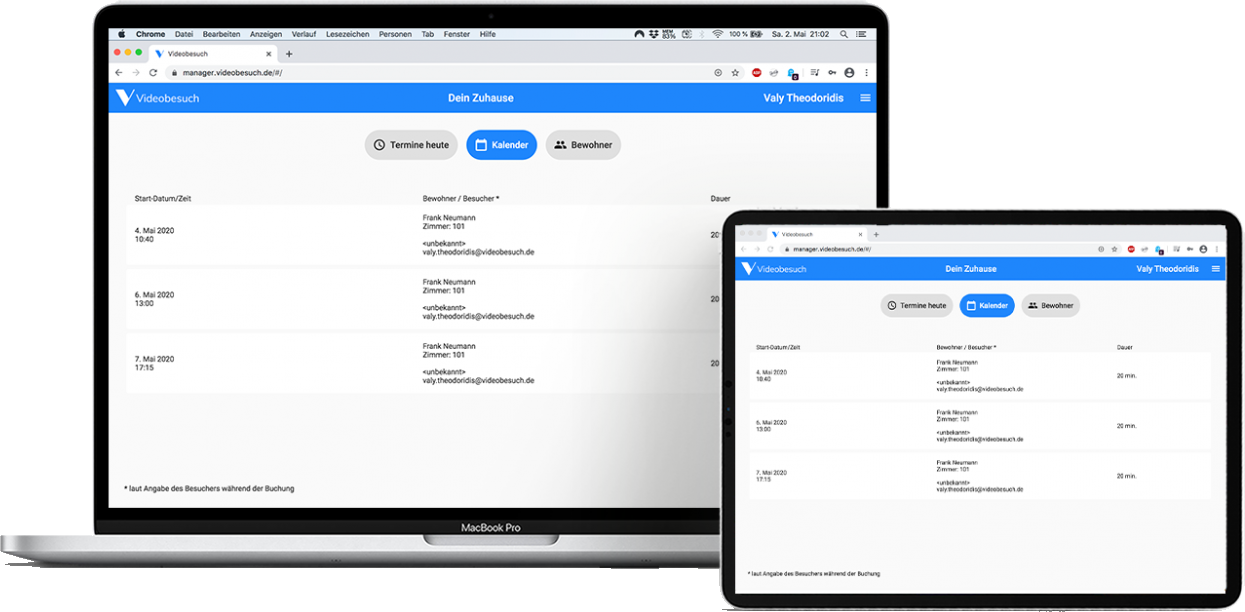
For Nursing Homes
The nursing homes don’t use mobile phone in their day to day operations, so we focused on building a web-app.
Our web app includes a list and calendar view of all appointments, as well as a list of all residents for data matching.
We were able to reduce the entire process to a point, where the only task left for the nurse is to take the tablet to the resident at the appointed time. As long as our web app is open, the call will automatically starts at the designated time and closes at the end of the set timeframe.

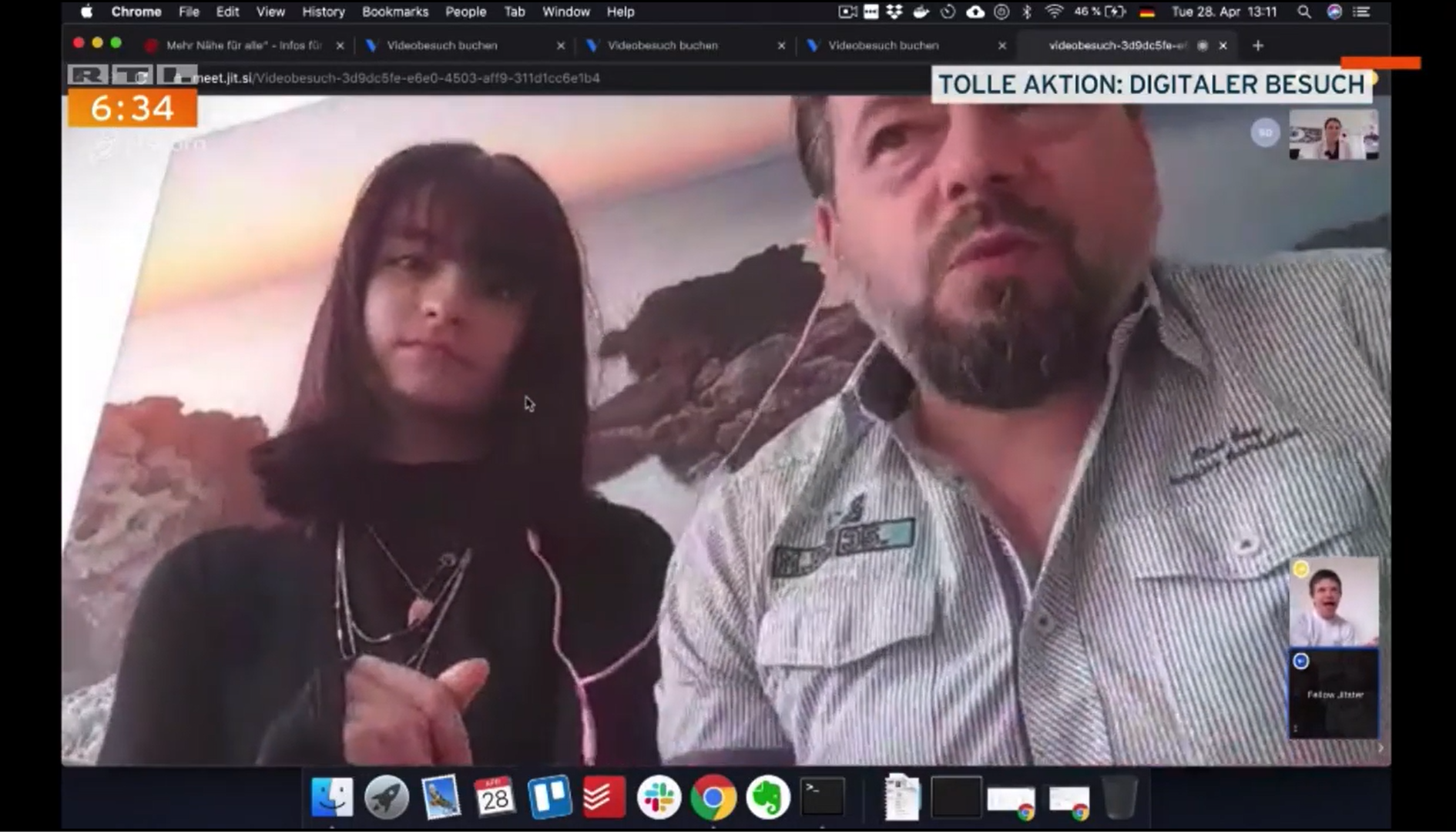
We kept the UI very simple. There’s no way for residents to hang up, there’s no option to mute/unmute yourself or turn the camera off or on.
Once the call starts, the volume is automatically set to maximum and the camera and microphone is automatically turned on.
That way we made sure of 2 things:
- The nurse doesn’t need to be there during the call to adapt any settings.
- The resident doesn’t have to change anything at all and can’t accidentally take any action that would cause them stress and the nurses an additional time effort.